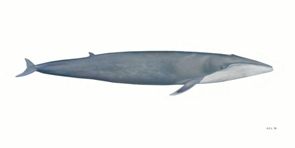Species Index


Key Facts
Length: Up to 33 metresRange: Global distribution, except for northern Arctic Ocean and Mediterannean Sea
Threats: Acoustic disturbance, pollution, ship strikes
Diet: Mainly plankton
Blue Whale
Latin: Balaenoptera musculus
Gaelic: Muc-mhara-mhor
Physical Description
At up to 33 metres in length, the blue whale is thought to be the largest animal ever to have lived on Earth. Calves can measure seven metres in length at birth. Upon surfacing, the splashguard in front of the blowhole is normally the first area to break the surface, which is followed by a powerful, columnar blow ten metres tall. The relatively small, curved dorsal fin is seen well after the blow as it is positioned far down the back of the long, tapered body. The huge tail fluke is often raised out of the water when the animal dives. Blue whales are actually a mottled light grey colour, but they appear blue under the water.
Habitat and Distribution
Blue whales can be found throughout all of the major oceans and occur in both coastal and oceanic waters; the only exception is the far north of the Arctic Ocean. It is thought that blue whales undertake seasonal migrations between feeding and breeding grounds although the exact movements are not well understood. Records of blue whales in Hebridean waters consist of several strandings but no live sightings.
Behaviour
Blue whales are normally seen alone or in small groups and occasionally associate with other whale species. In some areas they have been observed breaching, although this is an activity normally only attempted by calves. They produce powerful, low frequency sounds that can travel for hundreds of miles through deep water; these may be used for communication and/or navigation.
Food and Foraging
Feeding almost exclusively on zooplankton (mainly krill), they lunge into dense patches of prey and consume as much as 5500 kg of food each day. The prey is filtered from the seawater through large baleen plates before being swallowed. Other species may be incidentally consumed with plankton such as small fish, squid and crustaceans.
Status and Conservation
It is estimated that there are 5,000 to 12,000 blue whales worldwide, but as few as 400 animals may occur in the North Atlantic. As with many other whale species, the blue whale is still recovering from population depletions caused by commercial whaling. A possible threat to blue whales off the UK coast are the loud noises produced during offshore oil and gas exploration and drilling, which may interfere with the low frequency vocalisations made by the whales. Other threats include pollution, marine litter (entanglement and ingestion) and ship strikes. Blue whales are protected under UK and EU law, principally under Schedule 5 of the Wildlife and Countryside Act 1981, the Nature Conservation (Scotland) Act 2004 and by the 1992 EU Habitats and Species Directive.





